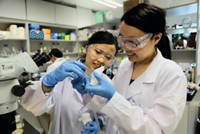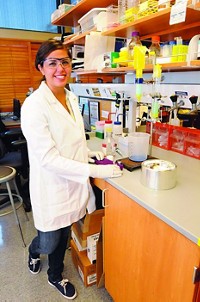Advertisement
Grab your lab coat. Let's get started
Welcome!
Welcome!
Create an account below to get 6 C&EN articles per month, receive newsletters and more - all free.
It seems this is your first time logging in online. Please enter the following information to continue.
As an ACS member you automatically get access to this site. All we need is few more details to create your reading experience.
Not you? Sign in with a different account.
Not you? Sign in with a different account.
ERROR 1
ERROR 1
ERROR 2
ERROR 2
ERROR 2
ERROR 2
ERROR 2
Password and Confirm password must match.
If you have an ACS member number, please enter it here so we can link this account to your membership. (optional)
ERROR 2
ACS values your privacy. By submitting your information, you are gaining access to C&EN and subscribing to our weekly newsletter. We use the information you provide to make your reading experience better, and we will never sell your data to third party members.
Education
International Exchange
What Puerto Rico, Hong Kong, and Canada can teach other countries about chemistry education
September 2, 2013
| A version of this story appeared in
Volume 91, Issue 35

Chemistry professors are always looking for the best methods to instill in their students a love for the subject as well as a solid understanding of the science.
Contents
Puerto Rican Tradition, 58
Mentoring and research programs help undergraduates thrive in chemistry.
Reforming Hong Kong, 60
Curriculum changes inspire undergraduates to innovate.
Canadian Masters, 62
Master’s graduates’ strong research experience attracts industry job offers.
In this year’s Back to School feature package, C&EN proffers snapshots of three places—Puerto Rico, Hong Kong, and Canada—that teach chemistry in ways that may inspire teachers in other parts of the globe.
In the first article of the package, Senior Editor Susan J. Ainsworth examines how chemistry departments in Puerto Rico have built strong mentoring programs and devised ways to provide valuable research experiences to their undergraduate students. The nurturing environment helps students succeed in chemistry and augments a rigorous chemistry curriculum at a time when budget constraints and cuts to federal programs are straining resources.
Hong Kong’s large-scale experiment in educational reform is the focus of the second story of the package, written by Senior Editor Linda Wang. During the 2012–13 academic year, all eight publicly funded universities in the country converted from a three-year undergraduate curriculum to a four-year curriculum. This transition put the chemistry departments in a unique position to completely revamp their curricula and introduce innovative approaches to teaching. The hope is these changes will create a cultural shift from a rigid system focused on test scores to an environment of creativity and innovation.
In the final story, Wang looks at master’s degree programs in Canada to find out why their chemistry graduates are being snapped up by large U.S. companies like Genentech. She reports that the programs’ emphasis on research, publishable results, and strong communication skills allows their graduates to hit the ground running. But even these successful programs aren’t immune to the sluggish economy, and they are continuing to innovate to stay ahead of the curve.




Join the conversation
Contact the reporter
Submit a Letter to the Editor for publication
Engage with us on Twitter